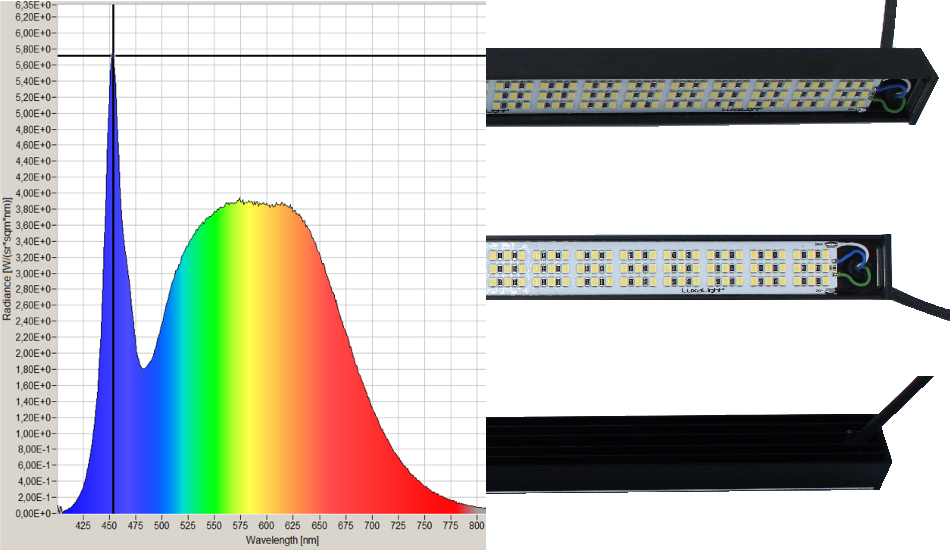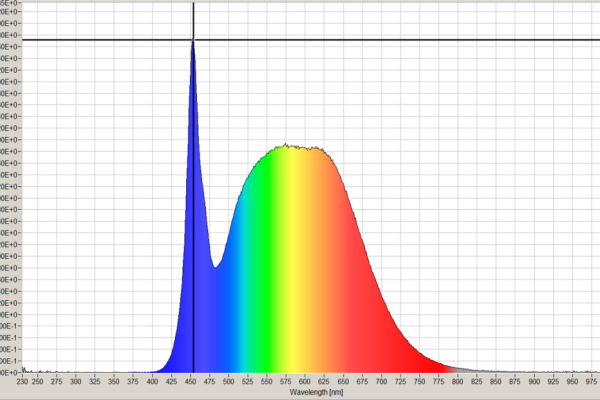PAR, PPF en PPFD
Using PAR, PPF and PPFD statistics, it can be read how much usable light a fixture produces and how much of that light reaches the crop.
Grow lights use different metrics than regular lights. Regular lamps are rated by the lumen output. Lumen is the unit of measurement that indicates how bright light is to the human eye. The human eye is most sensitive to the yellow/green/orange spectrum. However, plants need a different kind of light and make more use of the blue and red spectrum for their growth process. That's why we don't talk about lumens when growing plants, but about Photosynthetically Active Radiation, abbreviated PAR. Photosynthetically active radiation covers all wavelengths from blue to red, from 400-700 nm. PAR is the range of light that plants use for photosynthesis. Plants need a lot of light within the PAR range.
PAR
A PAR measurement is indicated by naming the number of photons emitted within the PAR range. This measurement determines how much PAR light a lamp emits. When measuring light, we talk about the number of photons that are emitted over a certain surface over a certain period of time. Mole is the expression used for this energy measurement. A micromole (umol) is one millionth of a mole and can also be defined as 1 μmol. When we talk about the amount of light that comes out of a fixture, we always talk about micromoles.
PPF
PPF refers to photosynthetic photon flux and is the best measure of how much total PAR light a fixture can provide. It is a measurement of the total number of photons of PAR light that a fixture emits per second. Often there is some fluctuation in the light quality, frequently not even perceptible to the human eye. Fluctuation will be almost nothing in high quality LED grow light. But accuracy is essential in any lighting system, which is why manufacturers display the average PAR output, rather than an arbitrary moment of measurement.
The measurement of PPF is done using a bubble test. In this test, the luminaire is placed in a round sphere and the total number of PAR photons emitted by the luminaire is measured in all directions. The sphere test tracks the number of PAR photons per second. The results are expressed in uMol/s (micromoles per second). The real power of a grow light can therefore be read in the PPF light output. Luminaires can best be compared by looking at the PPF. The PPF light output does not reflect the number of photons that will reach your plants.
PPFD
PPFD, indicates how much light will reach your plants. PPFD, or photosynthetic photon flux density, refers to the number of PAR photons ending up on a given surface every second. This is measured in micromoles per square meter per second and expressed as umol/m²/s. PPFD is generally measured with a PAR meter that can be placed at any location or elevation to see the actual light at that spot. A PAR meter usually measures the light coming directly from the light source. The PPFD varies by fixture. Factors that play a role: how far is the fixture from the canopy and how many fixtures overlap and illuminate the plant in question, are reflective walls used? Once the PPFD is known, you know how much PAR light reaches the crops at each measured point. Each plant species has specific PPFD requirements to get the best yield. The PPFD and area of influence of the grow light should be matched to the canopy of the plant. Most LED fixtures are designed for a specific suspension height and specific area of influence.
Uniformity
Uniformity is about how evenly the light is spread across the room. A grow light can have a high PPFD, for example in the middle of the light and at 70 cm high, this results in the light on the sides being much lower and the yield on the sides being less than in the centre. Manufacturers issue a PPFD card for the fixture for this reason. With this PPFD card, the PAR light levels can be displayed on different surfaces and different suspension heights.
Contact us for more information.




